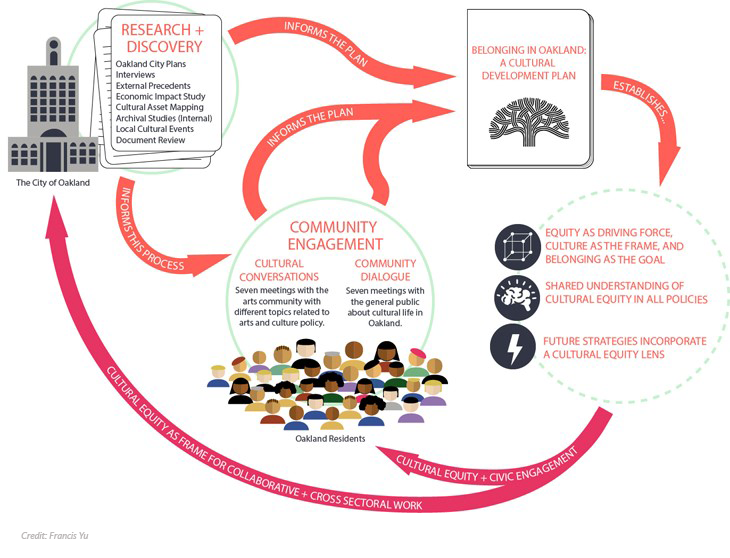Why Do a Cultural Equity Plan?
The face of the nation is changing. By 2044, people of color will be the majority in the United States. As cities and regions seek to build on this vibrancy, build intercultural community, and redress historic underinvestment in communities of color, many are developing and implementing cultural plans by bringing an explicit racial and ethnic demographic lens to planning. According to Americans for the Arts "cultural planning is a public process in which representatives of a community undertake a comprehensive community assessment and create a plan of implementation for future cultural programming." A Cultural Plan helps towns, cities, counties, regions, and states take account of their cultural assets, strengthen their economies by leveraging these assets, facilitate deeper social cohesion, and support the vibrancy of communities by focusing on what makes them so great in the first place: culture. (For simplicity in this tool, we will refer to all these variations in jurisdictions as "cities".)
Many cities across the country conduct periodic cultural plans or include an arts and culture chapter in their comprehensive plans. A growing number of those include an explicit equity approach, looking to ensure that diverse racial and ethnic communities are recognized in civic life, equitably served by arts and cultural offerings, and equitably invested in. This burgeoning approach is one step in the right direction toward achieving cultural equity.
"Cultural equity embodies the values, policies, and practices that ensure that all people — including but not limited to those who have been historically underrepresented based on race/ethnicity, age, disability, sexual orientation, gender, gender identity, socioeconomic status, geography, citizenship status, or religion — are represented in the development of arts policy; the support of artists; the nurturing of accessible, thriving venues for expression; and the fair distribution of programmatic, financial, and informational resources." — Americans for the ArtsThrough this primarily online tool, we have adapted a form of planning that explicitly focuses on cultural equity as a dynamic, regular practice: a Cultural Equity Plan. This tool provides guidance and resources for agencies and communities who would like to complete a plan that is dedicated to accomplishing cultural equity in their neighborhood, city, county, or region. By pointing to equity-focused approaches of cities engaging in this practice, it serves to promote equitable development through arts and culture.
This resource is not a comprehensive cultural planning guide. We recommend "Developing a Strategic Cultural Plan: A Work Kit" by Louise K. Stevens for a more comprehensive look at cultural planning in general. The point of this tool is to demonstrate the equity components that can be applied to each stage of development of a Cultural Equity Plan.
What is cultural equity? Cultural equity explicitly values the unique and collective cultures of diverse communities and supports their existence in physical spaces, in public policies and investment, and in expression in civic and spiritual life. A Cultural Equity Plan values interculturality—the recognition and support of diverse and distinct cultures and the bridging and sharing of those cultures to build strong and interconnected communities, towns, and cities. Cultural equity explicitly addresses legacies of structural racial discrimination and remedying of institutionalized norms that have systemically disadvantaged categories of people based on race, ethnicity, customs, gender identity, sexual orientation, age, religion, disability, and socioeconomic or citizenship status. Cultural equity reverses economic disinvestment to ensure healthy and thriving communities where people feel a sense of belonging.
The development of a successful Cultural Equity Plan requires an intentional process. It generally will be spearheaded by an arts and cultural agency, but cannot be accomplished without integrated leadership by the arts and cultural organizations and businesses that represent and serve the diverse communities of color in a city. Furthermore, advancing cultural equity is not limited to any one sector. For instance, the departments of planning, transportation, parks, housing, economic development, and public works; and general or neighborhood-specific plans should also address and support cultural equity. Regardless of which sectors or place-based initiatives within a city are attempting to plan for cultural equity, intentional practices that contribute to an equitable plan include data disaggregation, participatory research, and creative design processes that manifest community visions. Building in resources and time for government staff and community leaders to deepen their expertise is critical to achieving consistent, meaningful racial and social equity practices.
text0

